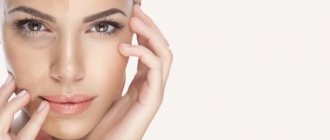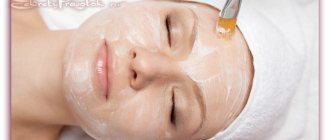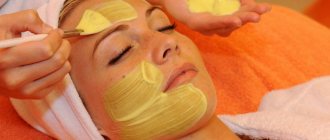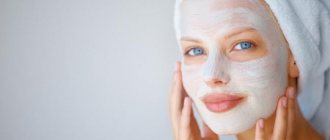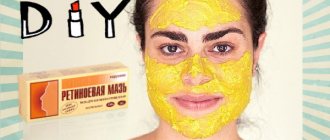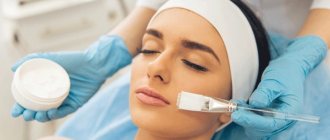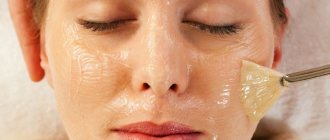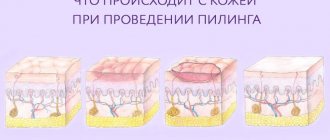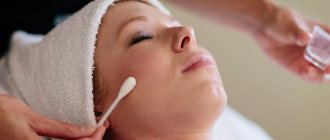You will undoubtedly be pleasantly surprised when you find out how beneficial milk peeling is for your facial skin. In cosmetology, it is one of the most effective drugs for combating skin imperfections.
And that's why:
- Lactic acid is an integral part of the skin's constituent components (natural moisturizing factor - NMF);
- Moisturizes, brightens, soothes the skin, reduces inflammatory manifestations, and also has an exfoliating effect;
- Refers to “summer” acids, that is, milk peeling can be used all year round;
Milk peeling is a targeted action on the skin with the aim of rejuvenating, moisturizing and superficially cleansing the skin, combating superficial wrinkles.
Indications and contraindications
However, milk peeling is a cosmetic procedure, and not a panacea for all facial imperfections. Therefore, it has both indications and contraindications.
Indications
Here are some facial problems you need to run to a cosmetologist for milk peeling:
- photoaging;
- dark spots;
- decreased tone and dyshidrosis of the skin;
- the appearance of superficial facial wrinkles;
- hyperkeratosis;
- acne - comedonal form of I degree;
- seborrhea.
Contraindications
Here's what milk peeling is incompatible with:
- individual intolerance to the components of the drug;
- presence of injuries on the face;
- inflammatory foci in the active phase;
- heart and vascular diseases;
- pregnancy;
- lactation period;
- malignant neoplasms;
- skin diseases (psoriasis, neurodermatitis, rosacea and others);
Contraindications for carrying out
Despite all its positive and gentle effects, milk peeling has a number of contraindications. Doctors do not recommend using lactic acid on the face in the following cases:
- skin diseases;
- scratches, cuts, cracks, burns, inflammation on the face;
- oncological diseases;
- herpes in the acute stage;
- During pregnancy and breastfeeding;
- fresh tan on the skin;
- diseases of the cardiovascular system;
- endocrine system disorders.
Before the procedure, you must make sure that there is no allergic reaction to lactic acid. You also need to understand that this product gives an anti-aging effect only in the early stages. Milk peeling does not eliminate deep age-related changes.
What happens during milk peeling
When using milk facial peeling, there is an increase in the intercellular matrix of hyaluronic acid and proteins, which are the structural elements of cells.
The procedure also helps to increase the thickness of the papillary layer of the dermis, which leads to an increase in the length of the dermal-epidermal junction. And this suggests the following: the exchange of oxygen, nutrients and waste between the avascular epidermis and the vascularized dermis will occur more actively.
One of the important properties of lactic acid is its ability to accelerate the process of cell renewal of the stratum corneum of the epidermis.
This is of great importance for various dermatological diseases, which are based on a violation of the keratinization process.
In addition to all of the above, lactic acid is able to regulate the pH of the skin towards an acidic environment. It will be an excellent addition in the treatment of dermatitis, acne, and fungal infections.
ATTENTION! Preparations based on lactic acid should not be used if the blood pH is below normal (oily skin - pH <4.0, normal skin - pH <5.2, dry skin - pH <5.7). Changes in pH values towards the acidic side can be observed with various skin diseases, for example, psoriasis.
Milk peeling with AHA - PHA complex "Lacti Peel+" 40%, 30 ml, Mesoderm
424158
Peeling preparation for all skin types with a pronounced hydrating effect, activator of regenerative potential. Restructures the skin, improves biomechanical properties. Reduces pigmentation, smoothes microrelief.
Milk peeling “Lacti Peel+” Mesoderm: characteristics
The effect of lactic aha acid 40% is potentiated by gluconolactone 6%, amino acid complex, hyaluronic acid 0.5% and hydrovanse active. The drug has a pH value of 2.7.
The component formula has high exfoliative properties, evens out and smoothes the skin texture, provides a visible super-hydration effect, and stimulates the synthesis of GAGs.
In addition, milk facial peeling has whitening and bacteriostatic properties and stimulates local immunity. Thanks to folic acid, the peeling solution has a stimulating effect on detoxification, which results in an improvement in complexion.
AHA peeling with lactic acid is well tolerated, has a short recovery period and is suitable for correcting problems in the presence of increased reactivity.
Milk multi peeling Mesoderm: indications
Lactic acid peeling, containing pha and aha acids, is used to solve various aesthetic problems.
- Effective for dehydration, hyperkeratosis and xerosis
- For hyperpigmentation of various origins
- For the purpose of correcting signs of photo-aging, atony and sagging, fine wrinkles, slow regenerative activity
- For post-acne spots, pigmentation, inflammation, increased sebum secretion and comedonal acne.
Thanks to the properties of lactic acid, the peeling composition strengthens the skin barrier function and reduces TEWL by increasing the amount of ceramides in the stratum corneum. The pronounced moisturizing effect of the drug causes minimal peeling and good tolerability.
Ingredients of professional milk peeling “Lacti Peel+” Mesoderm.
Lactic acid 40%
provides gentle exfoliation and pronounced hydration. As a component of NMF, it enhances the synthesis of ceramides by keratinocytes. Increases elasticity, eliminates symptoms of xerosis and reduces TEWL. It has antibacterial activity, regulates sebum secretion, brightens and evens out the color of the skin.
Polyhydroxy acid (PHA) gluconolactone 6%
has an antioxidant and hydrating effect, restores the integrity of the protective barrier, and reduces the effects of skin damage from UV rays. Has anti-inflammatory activity. It has an indirect effect on the proliferation of keratinocytes and the synthesis of HA.
AHA complex 1.5%
(citric, lactic, malic, glycolic, tartaric acids) with synergy with vitamin C and BHA. Gently exfoliates and enhances the effects of lactic acid, increasing hydration and stimulating regenerative processes.
Hyaluronic acid 0.5%
takes an active part in the proliferation, differentiation and migration of keratinocytes, enhances hydration, creates the effect of “additional moisture” and potentiates regenerative processes.
Folic acid 0.3%
— vitamin B9 strengthens local immunity, moisturizes and accelerates detoxification. It has antioxidant activity, stimulates regeneration and cellular metabolism. Has antibacterial and anti-inflammatory effects.
Hydrovanse (Hydroxyethyl Urea)
moisturizing active, enhances the hydrating effect of lactic acid, increases the elastic properties of the skin.
Amino acid complex
of 4 components: lysine, valine, isoleucine, glycine provides deep and prolonged hydration, restores barrier functions and helps reduce TEWL, smoothes microrelief.
Complex of mandelic, gluconolactonic and lactobionic acids
Low irritant characteristics have a hydrating, antioxidant and anti-inflammatory effect, enhancing the effects of the main acids of the drug.
Sage extract
inhibits inflammation, stimulates damage repair, reduces irritation and discomfort.
Rose damask extract
reduces reactivity, accelerates regeneration, has an anti-inflammatory effect. It has anti-edematous and vascular-strengthening properties, eliminates hyperemia.
Results of using Mesoderm milk multi-peeling for the face
Milk peeling for the face in cosmetology is widely used to correct various problems; it is carried out in a course, after which visible results are noted:
- Restoration of hydration and deep hydration, elimination of hyperkeratosis and signs of xerosis
- Strengthening protective functions due to activation of ceramide synthesis
- Restores complexion brightness and evens out skin tone due to pronounced detoxification and brightening effect of active ingredients
- Reduction of signs of involutional changes, photo-aging and smoothing of microrelief
- Accelerates regeneration and repair, increases resistance to stressors
- Reducing inflammation and the number of comedones, regulating the secretory activity of the sebaceous glands.
Recommendations for using milk peeling for the face “Lacti Peel+”
A week before the course protocol, preparation at home using a cleansing tonic (424156) is recommended.
FOR PROFESSIONAL USE ONLY
Areas of application: face, neck, décolleté. The drug is NOT used in the periorbital area and in the lip area. Do not apply to areas of skin with damage or irritation.
Before using Lacti Peel+, the skin is treated with PrePeel Cleanser Mesoderm lotion (424157) to degrease. Milk peeling is applied with a fan brush; application in 1-3 layers is possible. Each layer is kept for 2-4 minutes, the total time is selected individually. Neutralization is carried out with PP Neutra-Lotion Mesoderm lotion (424167).
After the session, it is recommended to use a serum with a cooling effect “PP Refresh serum” (424168) and a peptide soothing mask (424144).
Contraindications:
Intolerance to one or more components.
Combination with drugs:
| Pre-peel lotion with glycolic acid and AHA-PHA complex “Pre Peel Intence” 150ml, MESODERM | 424157 |
| Pre-peel cleansing mousse with lactic and ferulic acid “Pre Peel cleanser” 160ml, MESODERM | 424155 |
| Pre-peel toner with ferulic and lactic acid “Pre Peel Toner” 200ml, MESODERM | 424156 |
| Neutralizing lotion “PP Neutra-Lotion” 200ml, MESODERM | 424167 |
| Peptide soothing mask “Peptiderm - Active comfort”, MESODERM | 424144 |
| Photoprotective cream SPF 50, 100 ml MESODERM | 424143PRO |
| Photoprotective cream SPF 30, 100 ml MESODERM | 424141PRO |
| Post-peeling regenerating serum with a cooling effect “PP Refresh serum” 50 ml, MESODERM | 424168 |
| Post-peeling anti-stress cream 24 hours “PP Anti-stress 24h” 50 ml MESODERM | 424169 |
Release form:
bottle 30 ml
Manufacturer:
MESODERM.
Advantages and disadvantages
Lactic acid is an excellent product that helps make your skin look flawless and get rid of many problems. But still, peeling based on lactic acid will not get rid of all possible changes in the skin of the face, although it will help prevent and slow down their occurrence.
Cosmetologists include the following advantages of lactic acid-based peeling:
- intensively moisturizes the skin;
- easily removes dead skin cells;
- smoothes superficial wrinkles;
- skin tone improves significantly;
- fights pigment spots;
- the relief of the skin is evened out;
- the rehabilitation period after peeling is minimal;
- can be carried out all year round;
- versatility of peeling for skin types;
- pronounced comedolytic and bacteriostatic effect.
But milk peeling also has disadvantages:
- although rare, an allergic rash to the components of the drug does occur;
- deep wrinkles cannot be corrected.
As you can see, the disadvantages are minor. We can say that there are none at all: allergies can happen to everything, and to combat serious age-related changes, there are medium and deep peels.
By the way, you can find out what type of aging your skin will change in order to choose the right care!
What to expect after exfoliation?
If you choose milk peeling for your face, then you need to know what will happen to you after the procedure. In the first days after peeling, the skin will peel off a little. This is absolutely normal. You should not expect much peeling, since the effect is superficial.
Facial redness may be present, but not longer than 2 days. The feeling of warmth and slight burning should go away immediately after neutralization. If this does not happen, consult a doctor - you may have an allergic reaction.
Among the complications are:
- allergic reaction
- chemical burn.
By adhering to the following recommendations, you will make the milk peeling procedure as effective and safe as possible:
- if after applying the composition to the skin you feel discomfort or burning, then blowing cold air from a hairdryer will alleviate the condition;
- to protect the delicate skin around the eyes and lips, lubricate it with Vaseline before the procedure;
- be sure to watch the time, do not over-expose the composition;
- It is necessary to rinse off only with cool water;
- as a moisturizer after the main stage, choose creams with retinoids;
- the first session should begin with a minimum concentration, the concentration can be gradually increased;
- Do not comb skin that has been treated with acid;
- It is better not to use decorative cosmetics for 2 days;
- avoid sun exposure.
If you follow all the recommendations and advice of a cosmetologist, the milk peeling procedure will be successful, will bring only positive results and will not cause complications.
How to do milk peeling - step by step
Preparatory stage
On the eve of the procedure, you must avoid the solarium and hide your face from the sun's rays.
For three days, cosmetologists advise using lactic acid-based creams for gradual adaptation and, as a result, minimal side effects after the procedure.
Carrying out the procedure
- First, clean the skin. To carry out the procedure, a prerequisite is the presence of clean skin, which ensures uniform application of the drug to all areas of the skin.
- Toning. It is necessary to degrease and tone the skin.
- Pre-peeling. A special gel is applied to the face to prepare the skin for the application of lactic acid.
- Direct peeling. The drug is applied to the skin of the face, except for areas around the eyes and mouth, with a fan-shaped brush and cotton swabs. The drug should be applied in stages (forehead, temple, cheeks, then neck and décolleté, chin, around the mouth, nose, area around the eyes), in one or two layers with an interval of 10 minutes.
Exposure time depends on the expected depth of penetration of the drug (layers of the epidermis, dermis) - 2-20 minutes.
- Neutralization process. By applying a special composition, peeling is neutralized and water balance is restored.
Important! You can wash off any remaining products from your face only with cool water. Warm and, especially, hot water combined with lactic acid can cause skin irritation.
- Moisturizing and calming stage. To restore, calm, activate regeneration processes, as well as eliminate swelling, use appropriate masks and creams. Immediately after the procedure, be sure to apply a cream that contains SPF 30 or more.
Further skin care
You need to give your skin rest and the opportunity to recover. In the first few days, it is recommended to apply exclusively a moisturizer with an SPF of at least 30.
To achieve maximum results, it is recommended to take a course, which on average consists of 3 – 10 sessions with an interval of 8 – 14 days. This peeling can be repeated several times a year.
The recovery period lasts only a few days, but you must strictly follow the cosmetologist’s recommendations to achieve the maximum effect of the procedure.
Contraindications
Argipeel peeling should not be carried out during periods of exacerbation of chronic or inflammatory diseases. It is prohibited for diagnosed oncology. It is recommended for pregnant and nursing mothers to temporarily postpone the procedure.
Other contraindications to superficial peeling include:
- damage to the skin at the site of the procedure;
- herpes;
- rosacea;
- lactic acid intolerance;
- taking antibiotics.
You should not do the procedure in the first week after hair removal. Some of the described contraindications are relative. Patients with herpes may be allowed the procedure, but before it they will have to take a course of antiviral drugs. The decision on the advisability of peeling in the presence of certain contraindications is made exclusively by a cosmetologist.
To obtain a lasting result, it is recommended to undergo 4-5 peeling sessions. The intensity and duration of the skin healing course is determined by the cosmetologist during an individual examination of the patient. Make an appointment with specialists at the Absolut Med Aesthetic Medicine Clinic right now!
Side effects
Like all cosmetic preparations, milk peeling has its side effects:
- Severe redness, which is most often observed in those with sensitive skin. This can be easily corrected with Panthenol cream;
- A burning sensation during peeling, which disappears during the neutralization stage;
- After the procedure, slight peeling of the skin is observed in the first 2 to 4 days;
- Minor redness of the skin, which goes away on its own within a few days;
- It is extremely rare that burns can occur as a result of an unprofessionally performed procedure.
Results of milk peeling. Photos before and after
Milk peeling results before and after Illustration by Colady
Milk peeling procedures have a sebostatic effect - they regulate sebum production and normalize the functioning of the sebaceous glands. That is why they will be equally good for both dry and oily skin. The effect will be visible after the first procedure. This cosmetic procedure is not characterized by redness of the skin, swelling, or severe peeling, so it can be performed by very busy people who cannot take a break from work while performing milk peeling and skin restoration.
Milk peeling results:
- The skin surface is smoothed and structured.
- Skin cells are able to quickly recover and regenerate, skin renewal and rejuvenation occur.
- The production of collagen and elastin in the skin increases, it acquires firmness, elasticity, and tone.
- The skin becomes hydrated and takes on a radiant, healthy appearance.
- The skin brightens, freckles and age spots disappear or become noticeably lighter.
How to perform milk peeling at home
Peeling based on lactic acid is one of the most delicate, so it can be done even at home. Before carrying out this procedure, carefully read and become familiar with the stages of peeling.
Carefully! Be sure to follow all instructions listed. Before applying peeling, you need to do a tolerance test . To do this, apply a small amount of the drug to the inner surface of the forearm and observe the reaction. If after a few minutes there are no negative reactions in the form of severe burning or itching, then you can safely begin the procedure.
To prepare the peeling you will need lactic acid , it can be purchased in the form of a solution with a concentration of 40% and 80%, and water .
How to calculate how much acid and water you need to take to get the desired concentration? Let's start with the fact that it is not recommended to use peeling at home with a concentration of more than 20%. A 4% or 10% solution is best.
How to obtain a solution with the desired concentration of lactic acid
Let's consider the example of a 40% lactic acid solution.
- To get 10g of 4% peeling, you need to take 1g of acid and 9g of water (4x10:40).
- To get 10g of 10% peeling, you need to take 2.5g of acid and 7.5g of water (10x10:40).
After preparing the product, you need to clean and tone the skin, then apply peeling for 2-5 minutes and use cool water to rinse the product off your face and moisturize with cream.
Regular use of milk peeling will make your skin moisturized, radiant, and help get rid of fine wrinkles, acne and age spots.
Indications for peeling with lactic acid
- Unhealthy, dull complexion, stale skin.
- The presence of old excessive tanning, age spots on the skin, freckles.
- The presence of facial wrinkles, with loss of elasticity and skin tone.
- Periodic inflammation of the skin, acne, comedones.
- Consequences in the form of acne scars.
- Enlarged pores. Increased oily skin.
- Dryness and constant flaking of the skin.
- Allergic reactions to other types of peelings.
Milk peeling is recommended for everyone who does not have the opportunity to take a break from their work for procedures, since after this peeling there will be no redness or severe peeling on the skin.
Advantages and disadvantages
The advantage of milk peeling is minimal discomfort and pain.
Lactic acid does not cause allergies as it is natural to the skin. After a light superficial peeling procedure, there is no need to limit public events, since there is no severe peeling of the skin, and dead cells disappear in thin, imperceptible layers.
Salon milk peeling is allowed without preliminary pre-peeling preparation, since it is soft, gentle and can serve as a preparation for more serious procedures. Peeling with lactic acid does not dry out the skin, but on the contrary, it richly moisturizes it, restoring its protective capabilities, so it is a universal remedy for all skin types.
The procedure does not have a photosensitizing effect, so it can be used all year round, regardless of solar activity. In summer, use a cream with a minimum sunscreen filter SPF 60 and follow the recommendations of a specialist to avoid complications.
The results are visible after the first procedure: the skin will become smoother and velvety, and the complexion will become much more even..
Since milk peeling is superficial, you should not stock up on special care products after the procedure. You can use your regular moisturizer and UV protection products. To achieve maximum effect with prolonged action, you can periodically use cosmetics containing lactic acid.
Milk peeling can be used on different parts of the body and for different purposes, depending on the acid concentration. It is safe for those with dark and dark skin, as the risk of hyperpigmentation is very low. This type of peeling does not contain abrasive particles, so it can be used by patients with delicate and sensitive skin.
About the disadvantages
Some brands of milk peeling are quite aggressive; their use provides not superficial, but superficial-medium peeling. Before the procedure, you should check with the cosmetologist how long he has been working with this product and what results he has received.
It would be a good idea to find out what ingredients will be in the milk peeling, because for maximum whitening, some manufacturers add hydroquinone, which causes endocrine disruption, to the peeling composition. This toxic drug is banned in many countries of Western Europe, Central Asia, and Japan. Its effect is accumulative, so only local application is possible (on age spots).
Glycerin in creams at air humidity below 65% has the opposite effect, sucking water from the depths of the skin and holding it on the surface, instead of absorbing moisture from the air. After this application, dry skin becomes completely dehydrated.
To avoid such complications and unexpected skin reactions, it is necessary to study in detail the composition of all products used.

